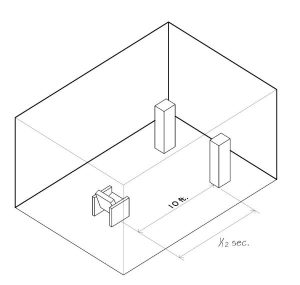Newsletter
Sound Masking from Head End Ringing
Heads & Masks
No, we’re not getting a jump start on Halloween or planning a masquerade opera. We are building upon last week’s discussion of timing and attack transient information, explaining how the dynamics, fine harmonic structure, and rhythmic speed of music are compromised by sound masking. As before, we look closely at the head-end ringing of your room.
Why this continued concern with the unusual notion of head-end ringing? Because it is one of the least understood aspects of room acoustics, and its effects on sound quality are far more detrimental than people realize. Early wall reflection control? Elementary. Corner bass trapping? Sophomoric. You are here to learn the real secrets of good-sounding rooms, and we try to deliver.
Read Art Noxon’s full article here!
Good Sound Masking? Well, it’s Not Actually Good, But…
If we are to rate the effectiveness of sound masking, the best masking comes from a sound that is just like the original, except that the masking sound is a time and phase scrambled version. The worst masking comes from a sound that is nothing like the sound that is being masked. How loud would a hiss sound have to be to mask the staccato tonal presence of a rapidly plucked bass guitar? Probably 40 dB louder than the guitar. If the guitar is being played at 50 dB, and a steam pipe hiss is kicked on at about 90 dB, maybe, just maybe, most of the guitar sound would be drowned out. This is not very effective masking.
But, if the reverberant sound of the guitar itself was used along with a wild set of time delayed attack transients mixed back in, we could sonically bury the guitar using a sound level that merely equals the guitar level alone. Now, that is effective masking. Post-masking is the psychoacoustic process of listening to a direct sound which is quickly followed by a sound masking type of sound. In the case of an uncontrolled room, the head-end ringing is post-masking the direct signal.
Arrival Time of Sound Versus Musical Rhythm
Let’s look at the statistical version of music. As an approximation, there are 8 separate sound bursts per second, which means each burst lasts 1/16 second and it is followed by 1/16 second of silence, in a perfect world. The head end ringing energy from the first attack transient begins arriving at the listener’s position 1/12th second after the leading edge is heard, which is slightly after the tone burst turns off.
Additionally, that same head end ringing is arriving at the listener at almost the same time that the next attack transient begins to arrive. That means the scrambled part of the first tone burst fills in this subsequent silent 1/16th second time period in the tone burst sequence.
Skilled Listening
There is another aspect of attack transients we need to take a look at. It’s about listening to music and understanding what we are hearing. When average people listen to music, they mostly hear the sequence of sustains. But when audiophiles and recording engineers, people heavily vested into the quality of the sound they are hearing, listen to music, they naturally or through training learn to focus on the sound of the attack transient. The truth of the sound is in the attack transient part of the sound, not in the sustain.
This is borne out through psychoacoustic testing. The fundamentals and upper partials of an attack transient define the coloration of the tone of an instrument. Some instruments can have exactly the same set of overtones and sound the same during the sustain but sound different when the attack transient is included. Tests have been done where the upper partials of an instrument are electronically time delayed, changing the relative phase of the fundamental to the upper partials. There is but only a slight recognition of the changes being made. However if the changes are made before each sound is struck, which includes the attack transient, the relative shifts of upper partial waveform timing are readily noticed. It was only when the phase alignment of the upper partials were included in the attack transient that synthesized musical notes began to sound real.
Dynamic Choking: Acoustic Compression?
If we are listening to a rapid sequence of tone bursts, we want to hear the fine structure of the leading edge of the attack transient. This is where the accuracy or irregularity of the upper partial harmonic structure of the musical tone is best perceived. The musicality revealing fine structure of the attack transient can be masked, obscured by excessive early reverberation, or as we call it: head-end ringing. We might electronically be revealing the top 15 dB of the attack transient, as it rises up out of the background din of ongoing sounds that are part of the music. However, due to head end ringing, we might only be able to sonically reveal the top 4 dB of the attack transient.
The real program material is delivering 15 db of dynamic range but with head end ringing being uncontrolled, the dynamic range is reduced to only 4 dB. Music suffers from a lack of dynamics because of the masking effect due to head end ringing. The music sounds as if it is compressed with a limiter. Secondly, we lost the ability to hear the lower 11 dB of the audible attack transient. We’ve lost the ability to hear a huge portion of the attack transient because lingering sound from head end ringing has back filled into the short period of electronic silence that actually is in the original music track. Not being able to hear more low level detail in the attack transient limits our ability to perceive upper partial musical detail, and the music simply sounds less real.
Natural, Faithful, Real.
There’s not a lot of debate when it comes to our playback systems sounding like real instruments and musicians: it is a phenomenal experience and a goal of almost every system. While we leave the purity of electrical signal transmission and conversion to vibrating air to the gear, interconnect, and speaker experts, the room acoustics play just as important a role in creating a truly musical experience.
Make your audio system more musically realistic today by adding TubeTraps to control your head-end ringing. The results sing for themselves!









